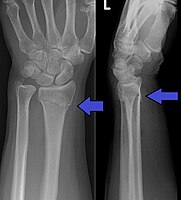
Photo from wikipedia
The purpose of this study was to evaluate the intermediate-term clinical and radiological outcomes for acute, unstable acromioclavicular joint (ACJ) injuries treated with the arthroscopically assisted BiPOD stabilisation technique. Twenty-three… Click to show full abstract
The purpose of this study was to evaluate the intermediate-term clinical and radiological outcomes for acute, unstable acromioclavicular joint (ACJ) injuries treated with the arthroscopically assisted BiPOD stabilisation technique. Twenty-three patients who sustained acute, unstable ACJ injuries were included in this prospective study. We recorded demographics, injury classification, time to surgery, clinical scores, radiological outcomes and complications; each patient completed a minimum of 2 years post-operative observation. Mean follow-up was 26 months (range, 24—34). Clinical outcomes scores demonstrated good 2-year results: relative Constant score, 97.9/100; ACJ Index, 89.4/100; Subjective Shoulder Value, 92.4/100 and Taft = 11.1/12. Final C–C distance showed a mean of 0.7 mm (SD ± 1.8 mm) at 2 years. Complication rate was 9%. The BiPOD technique shows excellent, reliable intermediate-term results with a favourable complication rate compared to existing techniques; it provides a comprehensive surgical option for the stabilisation of acute ACJ injuries restoring both vertical and horizontal stability.
Journal Title: Archives of Orthopaedic and Trauma Surgery
Year Published: 2021
Link to full text (if available)
Share on Social Media: Sign Up to like & get
recommendations!